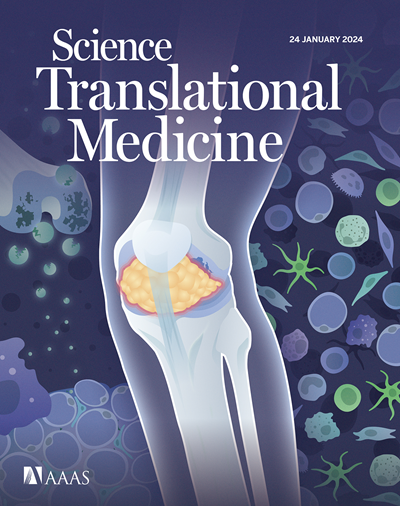Dysfunctional CD11c−CD21− extrafollicular memory B cells are enriched in the periphery and tumors of patients with cancer
IF 15.8
1区 医学
Q1 CELL BIOLOGY
Science Translational Medicine
Pub Date : 2025-02-19
引用次数: 0
Abstract
Many patients with recurrent and metastatic cancer fail to produce a durable response to immunotherapy, highlighting the need for additional therapeutic targets to improve the immune landscape in tumors. Recent studies have highlighted the importance of B cells in the antitumor response, with memory B cells (MBCs) being prognostic in a variety of solid tumors. MBCs are a heterogenous B cell subset and can be generated through both germinal center reactions and extrafollicular (EF) responses. EF-derived MBCs have been recently linked to poor prognosis and treatment resistance in solid tumors and thus may represent candidate biomarkers or immunotherapy targets. EF-derived MBCs, termed “double-negative” (DN) MBCs may be further classified on the basis of surface expression of CD11c and CD21 into DN1, DN2, and DN3 MBCs. CD11c−CD21+ DN1 MBCs and CD11c+CD21− DN2 MBCs have been well studied across inflammatory diseases; however, the biology and clinical relevance of CD11c−CD21− DN3 MBCs remain unknown. Here, we report an accumulation of DN3 MBCs in the blood and tumors of patients with head and neck squamous cell carcinoma (HNSCC) and an increase in DN3 MBCs in locally advanced HNSCC tumors. Circulating and intratumoral DN3 MBCs were hyporesponsive to antigen stimulation, had low antibody production, and failed to differentiate into antibody-secreting cells. Moreover, DN3 MBCs accumulated selectively outside of tertiary lymphoid structures. Last, circulating DN3 MBCs correlated with poor therapeutic response, advanced disease, and worse outcomes in patients with HNSCC and melanoma, supporting further assessment of EF-derived MBCs as potential biomarkers and therapeutic targets.
功能失调的CD11c - CD21 -滤泡外记忆B细胞在癌症患者的外周和肿瘤中富集
许多复发和转移性癌症患者不能对免疫治疗产生持久的反应,这突出了需要额外的治疗靶点来改善肿瘤的免疫环境。最近的研究强调了B细胞在抗肿瘤反应中的重要性,记忆B细胞(MBCs)在多种实体瘤中具有预后作用。MBCs是一种异质B细胞亚群,可以通过生发中心反应和滤泡外反应产生。ef衍生的MBCs最近与实体瘤的不良预后和治疗耐药有关,因此可能是候选的生物标志物或免疫治疗靶点。ef来源的MBCs,被称为“双阴性”(DN) MBCs,可以根据CD11c和CD21的表面表达进一步分类为DN1、DN2和DN3 MBCs。CD11c - CD21+ DN1 MBCs和CD11c+CD21 - DN2 MBCs已经在炎症性疾病中得到了很好的研究;然而,CD11c - CD21 - DN3 MBCs的生物学和临床意义尚不清楚。在这里,我们报道了头颈部鳞状细胞癌(HNSCC)患者血液和肿瘤中DN3 MBCs的积累,以及局部晚期HNSCC肿瘤中DN3 MBCs的增加。循环和肿瘤内的DN3 MBCs对抗原刺激反应低,抗体产生低,无法分化为抗体分泌细胞。此外,DN3 MBCs选择性地在三级淋巴结构外积累。最后,循环DN3 MBCs与HNSCC和黑色素瘤患者的治疗反应差、疾病进展和预后差相关,支持进一步评估ef来源的MBCs作为潜在的生物标志物和治疗靶点。
本文章由计算机程序翻译,如有差异,请以英文原文为准。
求助全文
约1分钟内获得全文
求助全文
来源期刊

Science Translational Medicine
CELL BIOLOGY-MEDICINE, RESEARCH & EXPERIMENTAL
CiteScore
26.70
自引率
1.20%
发文量
309
审稿时长
1.7 months
期刊介绍:
Science Translational Medicine is an online journal that focuses on publishing research at the intersection of science, engineering, and medicine. The goal of the journal is to promote human health by providing a platform for researchers from various disciplines to communicate their latest advancements in biomedical, translational, and clinical research.
The journal aims to address the slow translation of scientific knowledge into effective treatments and health measures. It publishes articles that fill the knowledge gaps between preclinical research and medical applications, with a focus on accelerating the translation of knowledge into new ways of preventing, diagnosing, and treating human diseases.
The scope of Science Translational Medicine includes various areas such as cardiovascular disease, immunology/vaccines, metabolism/diabetes/obesity, neuroscience/neurology/psychiatry, cancer, infectious diseases, policy, behavior, bioengineering, chemical genomics/drug discovery, imaging, applied physical sciences, medical nanotechnology, drug delivery, biomarkers, gene therapy/regenerative medicine, toxicology and pharmacokinetics, data mining, cell culture, animal and human studies, medical informatics, and other interdisciplinary approaches to medicine.
The target audience of the journal includes researchers and management in academia, government, and the biotechnology and pharmaceutical industries. It is also relevant to physician scientists, regulators, policy makers, investors, business developers, and funding agencies.
 求助内容:
求助内容: 应助结果提醒方式:
应助结果提醒方式:


